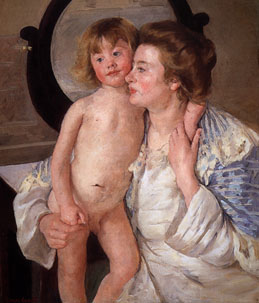
Mary Cassatt
Mother and Child, 1898.
Oil on Canvas, 81.6 X 65.7 cm.
Lent by the Metropolitan Museum of Art,
H. O. Havemeyer Collection
Bequest of Mrs. H. O. Havemeyer, 1929
1900: Art at the CrossroadsArt Review by Donald Goddard |
| We went to the top of the Guggenheim and began looking at paintings by Paula Modersohn-Becker, Mary Cassatt, and Elin Danielson-Gambogi when my wife Helen suggested that we were perhaps meant to begin at the bottom, in the first big gallery up the ramp. But we stayed at the top and went down instead, and when we arrived at the bottom it became clear that Helen was right. There was a text on the wall about the Exposition Universelle in Paris in 1900, which, it turned out, was the basis for this exhibition to begin with, and in the gallery were stacked (in the manner of that day) about 20 enormous paintings, including two by William-Adolphe Bouguereau that out-Renaissance the Renaissance, and a vast triptych detailing mountain and forest streams of thousands of naked children (along with swans in the right-hand panel) that might have been painted by one of today's Young British Artists. It wasn't. It was painted by the Belgian artist Léon Fréderic from 1890 to 1899. From our vantage point above, and even more so when we got there, the first gallery was like the last circle of hell, from which we were subsequently disgorged onto the streets of New York. Better as a beginning, I suppose, than an end. Maybe not. |
 Mary Cassatt Mother and Child, 1898. Oil on Canvas, 81.6 X 65.7 cm. Lent by the Metropolitan Museum of Art, H. O. Havemeyer Collection Bequest of Mrs. H. O. Havemeyer, 1929 |
|
|
Anyway, we began at the top, where the paintings by Modersohn-Becker, Cassatt, and Danielson-Gambogi of women with their children were combined with religious paintings and hortatory triptychs of various kinds--an interesting association. I guess we hoped that the emotional intensity and infallible patterning and structure of those first three paintings would continue. And so it did, occasionally, in Henry Ossawa Tanner's The Annunciation of 1898, in which the blinding abstraction of the angel's light is matched by the humanity of Mary's fear and strength, in several paintings by Edvard Munch, and farther down the ramp in Edouard Vuillard's luminous scene of his brother-in-law The Painter Ker-Xavier Roussel and His Daughter of 1903, several Cézannes, and a Gauguin still life.But there was always a sense of theirs and others' paintings being overwhelmed by the clamorous productions of their financially more successful, at the time, and socially more acceptable peers. What we are shown here, in proportion, is probably a more accurate picture of what actually went on than we are used to seeing. Impressionists, some Post-Impressionists, Symbolists, and a variety of individualists certainly claimed a strong presence in the last decade of the 19th century. Paris was more or less encouraging to all of them, to bohemianism as a subset of bourgeois life, and there were comparable or parallel movements in Germany, Austria, England, and elsewhere. But they did not and could not represent the dominant culture, which was indeed represented by the Exposition Universelle of 1900. |
|
Like all worlds' fairs (which died out in the
1960s to be subsumed by theme parks and the Olympic movement, not to speak of
trade and art fairs), the Exposition was a gigantic advertisement for progress,
for the triumph and glory of industrial society, and for the particular accomplishments
of the French nation, not the least as a global power and beacon of world peace
(fourteen years before the First World War). Like cathedrals in the age of the
church and chateaux in the age of absolute monarchy, art still had to be grand
in the age of the industrial republic.
|
|
|
|
Of course, it was the last gasp of grandness until Stalin and Hitler revived it in the 1930s. The period itself is rather nebulous, and the year 1900, as curator Robert Rosenblum points out in his contribution to the exhibition catalogue, "usually falls between the cracks, belonging neither to the mature flourishing of the Post-Impressionist giants in the 1880s nor to the early twentieth-century sequence of rebellious 'isms': Fauvism, Expressionism, and beyond." At the Exposition Universelle, two enormous buildings, the Petit Palais for French art from the middle ages to the eighteenth century and the Grand Palais for 19th-century art, were erected. It is interesting that the exhibition devoted to French art from 1800 to 1889 (the Exposition Centennale), which included work by Courbet, Daumier, Manet, Monet, Degas, Rodin, Cezanne, and Gauguin, as well as David, Ingres, and a host of academic artists, was far less conservative than the exhibition devoted to art of the 1890s (the Exposition Décennale), which included painting and sculpture from 29 countries. In other words, the grand, quasi-traditional art of the moment, mixing realism, idealism, allegory, religious fervor, and even social protest, held sway, as it does in this exhibition. Donald Goddard © 2000 |
Art Review - NYArtWorld.com - NYAW.com. All artwork is copyright of the respective owner or artist. All other material © Copyright 2016 New York Art World ®. All Rights Reserved.
New York Art World ® - Back to Top - Art Reviews Listings - Previous Review - Next Review